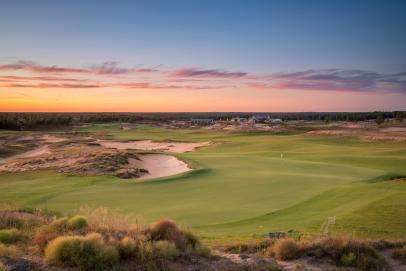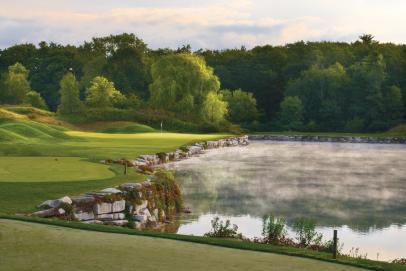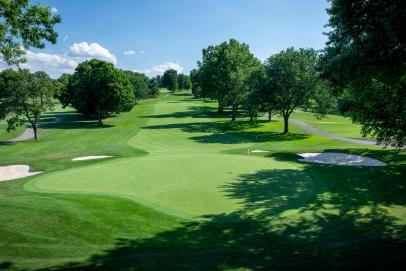COURSE RANKINGS
America's 100 Greatest Public Courses

We’re not shy about expressing enthusiasm for publishing the biennial list of Golf Digest's America’s 100 Greatest Public Golf Courses. Our marquee franchise, the America's 100 Greatest Courses ranking, is our authoritative survey of great golf course architecture, but it's also a little like ranking the world's greatest three-starred restaurants—where most of us will never be able to get a reservation.
Our public course ranking, on the other hand, is relative to all of us. It’s meant to be both a marker of exemplary golf design and a guide to where you might want to play, either soon or on a special occasion trip. The price tags on many of these courses may be forbidding but they’re nevertheless open to the public, and many of those on the second half of the list are quite reasonably priced for the level of golf they deliver.
Twelve courses fell off this year’s ranking, including longtime stalwarts Bay Harbor in Michigan (the Links/Quarry course), Pete Dye’s Bulle Rock in Maryland and the Mike Strantz-designed Caledonia Golf & Fish Club in Myrtle Beach. Also off is the former America’s 100 Greatest Courses member Pine Barrens at World Woods in Florida, not because it didn't score high enough, but because it doesn’t exist anymore—it’s being transformed into a new course at the rejuvenated Cabot Citrus Farms, expected to open January 2024. Will the new design be as worthy of this ranking as the old?
The dozen courses coming onto the ranking in 2023 represent several debut appearances in addition to a few that return after temporary hiatus. Wynn Golf Club in Las Vegas enters new at No. 66, the highest debut or return. Southern Pines in North Carolina, the beloved but scruffy old Ross course outside Pinehurst, makes its first appearance following a major remodel by Kyle Franz that brings it on par with sister courses Pine Needles (No. 63) and Mid Pines (No. 86). Buffalo Ridge in Missouri is back in the ranking for the first time since 2009, giving Big Cedar Lodge three courses in the top 100 along with Payne’s Valley (new at No. 78) and Ozarks National (33rd).
As always there are a number of big jumps in the rankings, as well as a few free falls. That’s part of the fun, as you’ll see here.
Below you'll find our latest ranking of America's 100 Greatest Public courses, based on thousands of evaluations from our course panelists.
We urge you to click through to each individual course page for bonus photography, drone footage and reviews from our course panelists. Plus, you can now leave your own ratings on the courses you’ve played … to make your case why your favorite should be ranked higher.























Most golf fans are familiar with Kapalua Golf Club’s Plantation Course, home of the PGA Tour's opening event each year. Located on the north shore of the Hawaiian island of Maui, the Plantation was built from open, windswept pineapple fields on the pronounced slope of a volcano and is irrigated by sprinklers pressured solely by gravity. As the first design collaboration by Bill Coore and Ben Crenshaw, it unveiled their joint admiration for old-style courses. The blind drive on the fourth, the cut-the-corner drives on the fifth and sixth are all based on tee shots found at National Golf Links. So, too, are its punchbowl green and strings of diagonal bunkers. It's also a massive course, built on a huge scale, Coore says, to accommodate the wind and the slope and the fact that it gets mostly resort play.









The Tom Weiskopf-designed Forest Dunes in Michigan is a terrific layout on a terrific piece of property, with sand dunes deposited by the nearby Au Sable River and covered with mature pines. But it's not a unique piece of property. When I first played it, I was struck by how much Forest Dunes resembles a Texas course designed by Weiskopf's former partner, Jay Morrish. That course, Pine Dunes in Frankston, Texas, is built on much the same terrain, sand dunes covered in pines. Though they were working at the same time on their respective projects (Forest Dunes was completed in 2000 but didn't open until 2002; Pine Dunes opened in 2001), I don't think Weiskopf or Morrish had any idea that they were working on such similar courses, and I don't think they stole each other's ideas. But it's uncanny how they created kissing-cousin courses. Or maybe not. The two worked together for over a decade before splitting up in 1996, and they shared a common philosophy of course design.





37. (44) The Broadmoor Golf Club East Course
Colorado Springs, CO

38. (46) Yale Golf Course
New Haven, CT








46. (51) CordeValle Golf Club
San Martin, CA




50. (41) Fallen Oak
Saucier, MS

51. (48) May River Golf Club At Palmetto Bluff
Bluffton, SC



54. (61) Crosswater Golf Course
Sunriver, OR














68. (79) Red Sky Ranch & Golf Club Fazio Course
Wolcott, CO


I like a lot of things about Mossy Oak, particularly the par-3 15th, a mirror image of the fifth at Hanse's Streamsong Black, which itself is a version of the Calamity hole at Royal Portrush, and I really liked the par-4 eighth, which plays over a creek and uphill between huge oaks to a green that slopes gently front to back. The par-4 13th is another fine hole, with a fairway that kicks left toward a stream, much in the manner of Merion East's fifth hole. I'm also a fan of the aforementioned 17th, which plays uphill to a plateau fairway into which that huge bunker is embedded. But it's 75 yards short of the green, which is well beyond the crest of the plateau and needs an extra tall flagstick just to pose a target. This is a very unusual hole. I'm also a fan of Hanse's bunkering at Mossy Oak. It's big sweeping stuff like seen as some Tillinghast designs such as Ridgewood. And the sand is earthen-toned, not bright white. Bryan told me they trucked it in from a river six miles away.A couple of things I didn't care for: The green on the par-4 second has two bunkers on its left flank that also serve as fairway bunkers on the par-5 fifth hole going in the opposite direction. Granted, the fifth fairway is probably 50 yards wide and those bunkers are midway between the tee shot landing area and the second shot landing area, but the lawyer in me still feels it's a lawsuit waiting to happen.

71. (63) The Dunes Golf & Beach Club
Myrtle Beach, SC




75. (66) Red Sky Ranch & Golf Club Norman Course
Wolcott, CO


77. (77) Reynolds Lake Oconee: Great Waters
Eatonton, GA

It was a long time coming. That’s not a reference to the three-and-a-half-years of construction and grow-in for Payne’s Valley, the newest resort course at Big Cedar Lodge near Branson, Mo. Rather, it had been 14 years since public golfers began waiting to play a course designed by Tiger Woods. Woods founded his design company, TGR Design, in 2006. But because of his schedule, the desire to be selective of the few projects he signs onto and a devastating financial crisis, only two TGR courses were been completed—the El Cardonal course at Diamante Cabo San Lucas in Mexico, and Bluejack National, a private course in Texas. Payne’s Valley, which opened in 2020, presents to the largest audience to date the architectural principles he most values. “My goal when starting TGR Design was to create courses that are fun and playable for golfers of all abilities,” Woods told Golf Digest. “This was particularly important at Payne’s Valley, my first public golf course.”

Dan Proctor and Dave Axland have been quasi-legends in the business of golf course construction for over 30 years now, individually and collectively. They've worked on many of Coore & Crenshaw’s prominent designs, including Sand Hills (Nebraska's premier layout, in the center of the state's vast sand hills) and Cabot Cliffs (Canada's premier layout these days). They even rated cameo appearances in Geoff Shackleford’s 1998 novel, The Good Doctor Returns. And they were also a talented course design team in their spare time, routing and building quality low-budget courses in the Coore & Crenshaw style. Their most prominent collaboration is Wild Horse in central Nebraska, a public “little brother” to Sand Hills, in slightly softer but still authentic sand hills, closer to civilization. Like at Sand Hills, Wild Horse is lay-of-the-land architecture routed without benefit of topographic maps, with natural-looking bunkers, native grass roughs and pitch-and-run shots galore. Total earth moved: 5,000 cubic yards. Total construction costs: a little less than $1 million.





















• • •
Explore Golf Digest's recently relaunched Places to Play community, where you can add star ratings and reviews for all the courses you play. We've collected tens of thousands of reviews from our course-ranking panelists to deliver a premium experience, which includes experts' opinions, bonus course photography and videos, plus much more. Check it out here!



